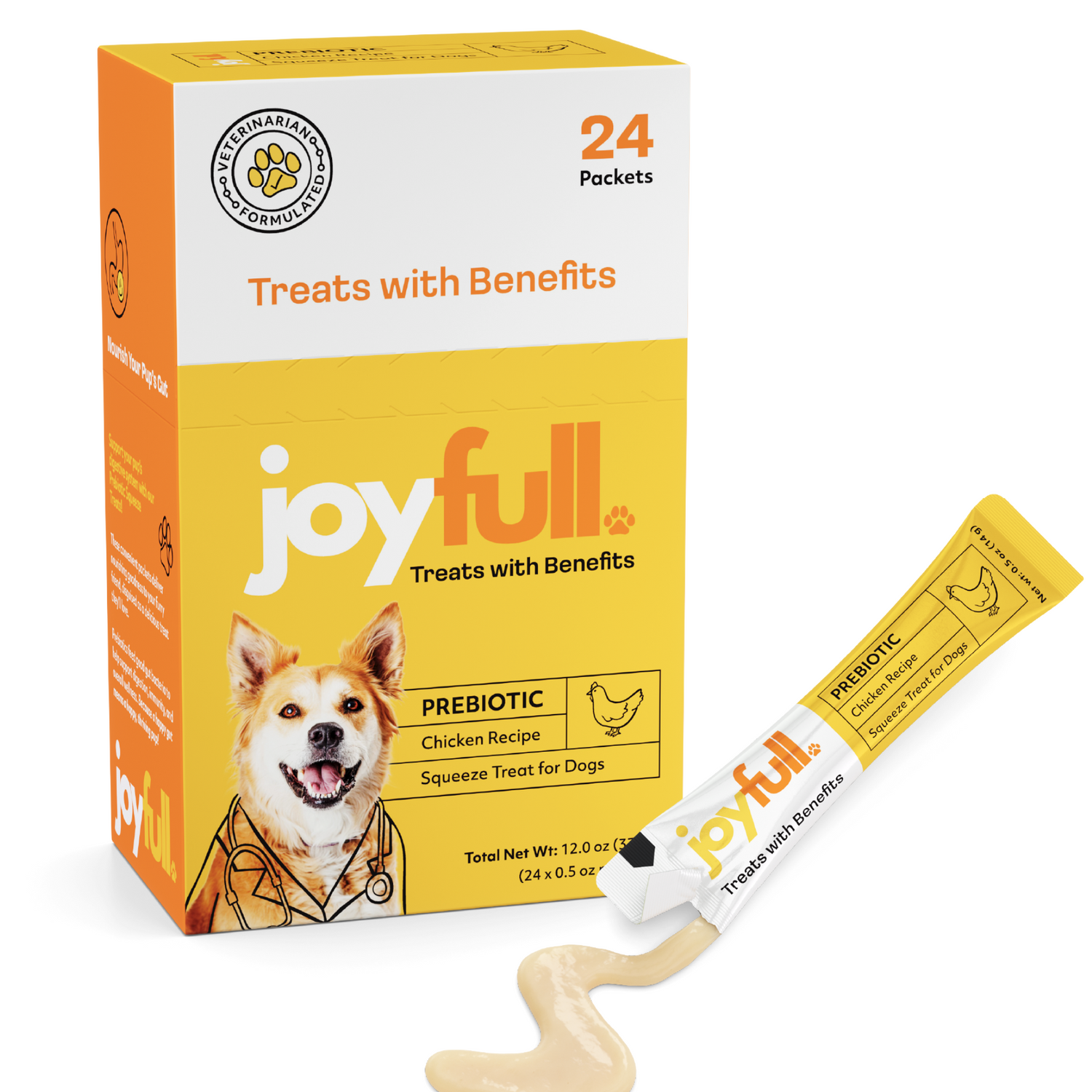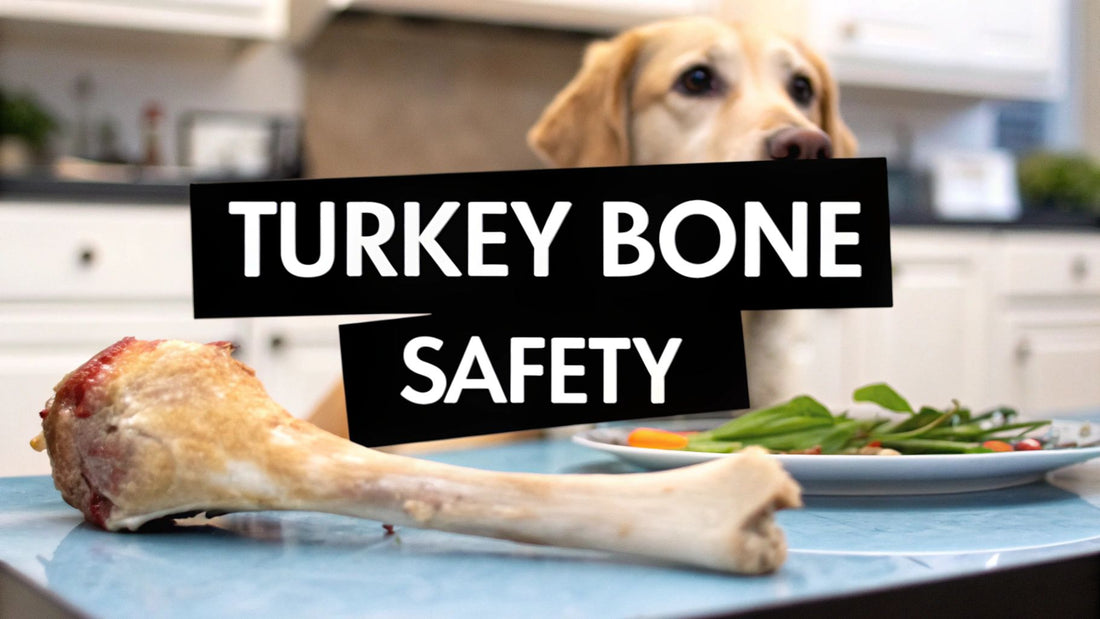
Can Dogs Eat Turkey Leg Bones? A Complete Safety Guide
So, you're looking at that leftover turkey leg from dinner and your dog is giving you the eyes. We've all been there. It’s so tempting to toss them a bone, but when it comes to cooked turkey bones, the answer is a hard and fast no.
Giving your dog a cooked turkey leg bone is a gamble you just don't want to take. They're incredibly brittle and can splinter the moment your dog starts chewing, leading to some truly scary and life-threatening emergencies.
Why Turkey Bones Are Off the Menu
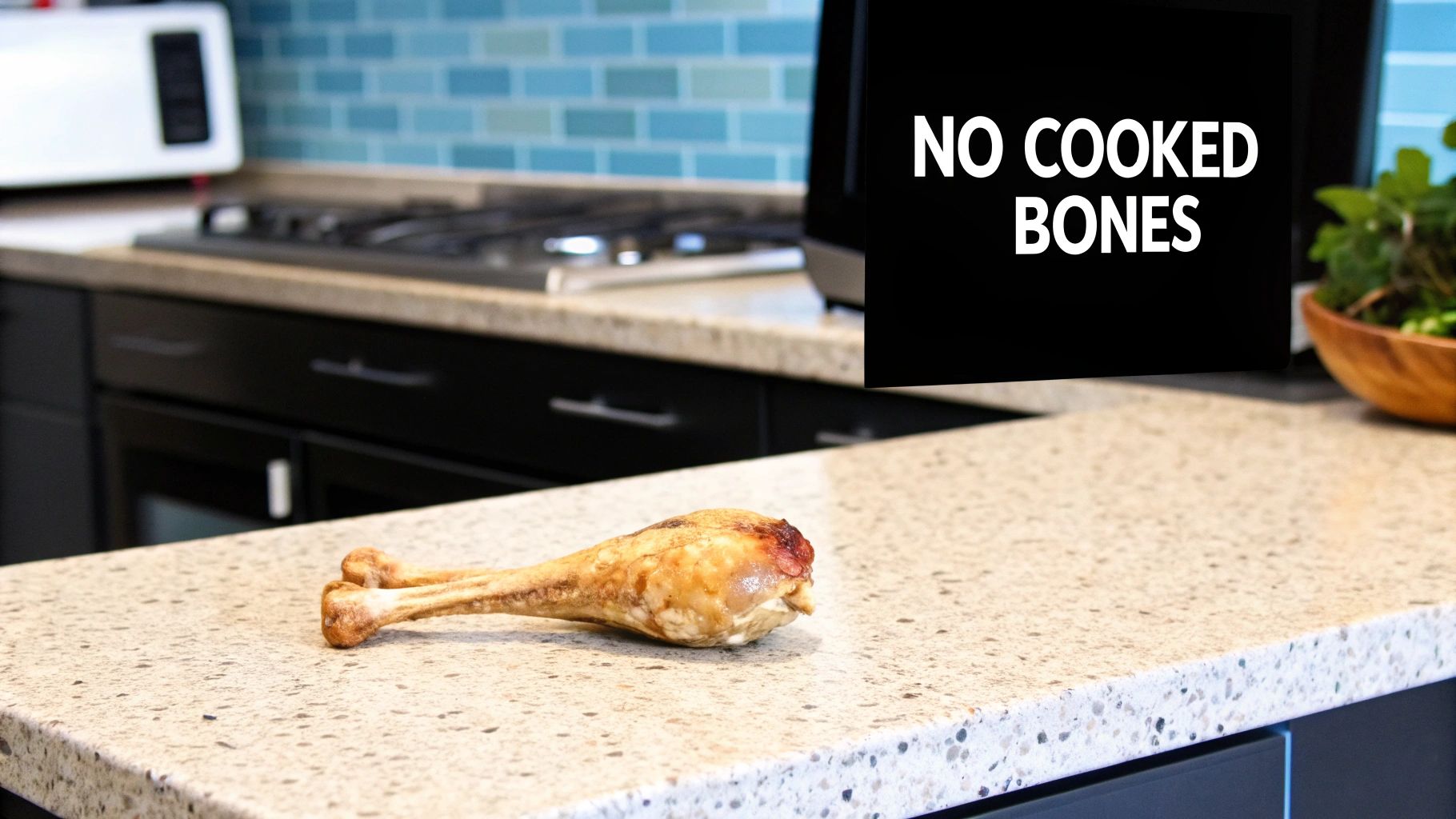
When people ask, "can dogs eat turkey leg bones?" they’re really asking about a major pet safety issue. The danger isn't the turkey itself, but what the cooking process does to the bone. Heat leaches out all the moisture and collagen, turning a once-flexible bone into something as fragile as glass. Unlike other food debates, like if dogs can eat fish, this is one topic where vets overwhelmingly agree: cooked bones are a bad idea.
It's no coincidence that vet clinics see a huge spike in emergency visits around the holidays. A dog's powerful jaws can snap a cooked bone into sharp, jagged pieces in an instant. These splinters can cause all sorts of damage, from choking hazards to perforated intestines. It's a preventable emergency that lands thousands of dogs in the vet's office every single year.
The real problem isn't the bone itself, but what cooking does to its structure. A cooked turkey bone is a completely different beast from a raw one, carrying a much higher risk of splintering and causing serious internal harm.
To make the distinction crystal clear, let's break down the differences between giving your dog a cooked bone versus a raw one.
Cooked vs Raw Turkey Bones: A Quick Risk Comparison
This table shows exactly why one is a dangerous gamble and the other is a topic for careful consideration with your vet.
| Attribute | Cooked Turkey Leg Bones | Raw Turkey Leg Bones |
|---|---|---|
| Texture & Durability | Brittle and weak. The cooking process removes moisture, making them prone to shattering into sharp shards. | Softer and more pliable. They are less likely to splinter and can be chewed down more safely. |
| Choking Hazard | High. Splintered fragments can easily get lodged in the throat or airway. | Moderate. Risk still exists, especially if the bone is too small for the dog's size. |
| Internal Injury Risk | Very High. Sharp fragments can puncture the esophagus, stomach, or intestines, causing internal bleeding and severe infection. | Lower, but not zero. Can still cause blockages or, in rare cases, splinter. |
| Dental Health | Potential for damage. Hard, brittle pieces can fracture teeth. | Can be beneficial. Chewing helps scrape away plaque and tartar, but can also cause fractures if the bone is too hard. |
| Nutritional Value | Minimal. Most nutrients are degraded by the cooking process. | Rich in calcium and phosphorus. Provides essential minerals and mental stimulation. |
| Bacterial Risk | Low. Cooking kills most bacteria like Salmonella and E. coli. | High. Raw bones can carry harmful bacteria, posing a risk to both pets and humans. |
As you can see, the cooking process is what turns a potential treat into a serious hazard. While raw bones come with their own set of risks (like bacteria), they don't have the same splintering danger that makes cooked bones so dangerous for our dogs.
Why Cooked Bones Are a Serious Hazard for Dogs
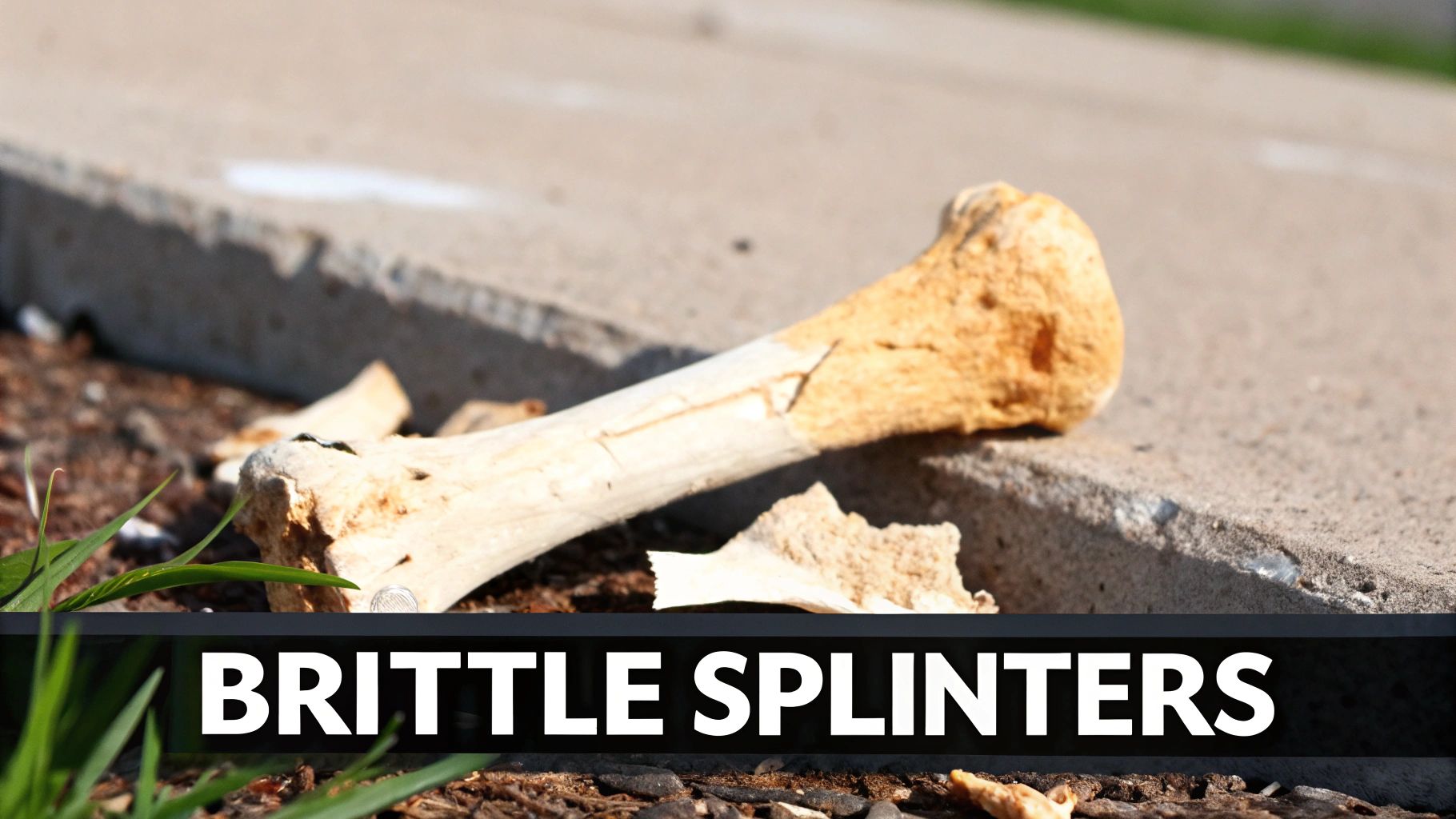
The biggest problem with cooked bones comes down to a simple change that happens when they're heated. Think about a fresh, green twig from a tree—it’s flexible and will bend if you put pressure on it. Now, picture that same twig after it's been left out in the sun to dry for weeks. It becomes brittle and snaps into sharp, pointy shards. That's exactly what cooking does to a turkey leg bone.
This change in structure turns what seems like a tasty treat into a genuine danger. When your dog’s powerful jaws clamp down on a cooked bone, it doesn't just break; it shatters. This creates dagger-like fragments that can cause a whole host of painful, life-threatening injuries long before they even get to the stomach.
The Journey of a Splinter
Once a dog swallows these sharp pieces, the real danger begins. The trip through the digestive system is a minefield, with plenty of opportunities for things to go horribly wrong.
Here are some of the most common injuries veterinarians have to deal with:
- Mouth and Throat Damage: Those jagged edges can easily slice a dog's tongue, gums, or the inside of their cheeks. Worse, a larger piece can get stuck in the throat, creating an immediate choking hazard that requires an emergency trip to the vet.
- Esophageal Punctures: As the splinters travel down the esophagus, their sharp points can tear or even puncture the delicate lining. This is an incredibly painful injury that can lead to all sorts of serious complications.
- Stomach and Intestinal Perforation: If the fragments make it all the way to the stomach or intestines, they can pierce right through the organ walls. This is a nightmare scenario, as it allows bacteria and digestive fluids to leak into the abdomen, causing a severe, life-threatening infection called peritonitis.
The risks associated with feeding dogs turkey bones are not just theoretical. Cooked poultry bones are infamous for their brittleness. In fact, some studies suggest that up to 30% of gastrointestinal emergencies in dogs are tied to ingesting cooked bones, which can lead to internal injuries, blockages, and severe infections. You can learn more about these veterinary findings to see just how common this is.
Blockages Requiring Emergency Surgery
Even if the bone fragments don't puncture anything, they can still clump together and create a complete intestinal blockage. This is a full-blown surgical emergency. The digestive tract gets completely obstructed, and nothing can pass through.
Without immediate, often expensive, surgery, a blockage like this is usually fatal. This is precisely why when pet owners ask, "can dogs eat turkey leg bones?" they get such a firm "no" from vets. The risk of a high-stakes emergency just isn't worth a few minutes of chewing.
The Hidden Dangers Go Way Beyond Splintering
We all know cooked bones can splinter—it’s the classic warning. But that’s honestly just the tip of the iceberg. The real dangers are often less obvious and can turn a holiday treat into an emergency vet visit before you know it.
Let's start with a big one: pancreatitis. This is a nasty, painful inflammation of the pancreas, and it can be triggered by a sudden high-fat meal. A turkey leg isn't just bone; it's packed with rich marrow, fatty meat, and skin. For a dog's digestive system, that sudden fat bomb can be overwhelming, causing the pancreas to go into overdrive.
The Bacterial Minefield
Think about that turkey sitting on the counter during Thanksgiving dinner. It’s the perfect breeding ground for bacteria, and those germs don't just disappear. Handing that bone to your dog means you’re also handing over a dose of some pretty harmful stuff.
Two major culprits are always lurking on raw or improperly stored poultry:
- Salmonella: This one is notorious for a reason. It can cause awful gastrointestinal issues in your dog, like fever, vomiting, and bloody diarrhea. Worse yet, a sick dog can easily spread it to the humans in your home.
- E. coli: Just like salmonella, E. coli can lead to severe stomach upset. A contaminated bone is a direct route for this bacteria to infect your dog.
The longer that bone sits out, the more bacteria are having a party on it. That leftover scrap from the table can be teeming with microorganisms that will make your dog incredibly sick.
A One-Way Ticket to the Doggy Dentist
Even if you get lucky and the bone doesn't splinter or make your dog sick, their teeth are still in the line of fire. Cooked bones are brittle and hard—almost like rocks. When a dog chomps down with all their might, something has to give, and often, it's their teeth.
This can lead to some seriously painful and expensive dental work. We're talking about chipped or broken teeth, which can expose the sensitive nerve and lead to agonizing pain and infections. The sharp, fractured edges of the bone can also slice up your dog's gums and tongue. These aren't minor scrapes; they're deep cuts that almost always require a vet's help, and sometimes, even tooth extractions.
What Vets Around the World Have to Say
If you ask a veterinarian, "Can my dog have this turkey leg bone?" you'll get the same answer whether you're in Des Moines or Dublin. The response from the global veterinary community is a firm and consistent "no." This isn't just an overcautious opinion—it's a warning built on years of treating the grim, and sometimes tragic, results of a seemingly innocent treat.
Major veterinary groups across the world, from the American Veterinary Medical Association to its counterparts in Europe and Australia, all sing the same tune: cooked bones are a major hazard for dogs. The science is simple. Cooking a bone dehydrates it, stripping away its flexibility and making it brittle. What was once a sturdy bone becomes a splintery, dangerous object.
The global veterinary community is united on this. Their advice isn't theoretical; it's based on the real-world emergencies they handle every single day—from choking dogs to animals needing life-saving surgery for internal punctures caused by sharp bone fragments.
A Problem That Knows No Borders
This isn't just an American issue tied to Thanksgiving dinner; it's a worldwide pet safety concern. Animal ERs from continent to continent report seeing the same horrible injuries, often with a spike around holidays when families are more likely to share their meals.
Take Australia, for example. The Animal Emergency Service regularly deals with severe complications from dogs eating cooked bones, including everything from internal bleeding to raging abdominal infections. Considering that up to 60% of pet owners admit to sharing table scraps, the odds of a dog getting their paws on a dangerous bone are frighteningly high. This international pattern is exactly why vets are so vocal about warning against the practice. You can read more about these common emergencies and why cooked bones are so dangerous for dogs.
The message from vets is clear and direct: the risks just aren't worth it. Their guidance is all about prevention, helping you sidestep a trip to the emergency vet that is not only scary and expensive but also completely avoidable.
What to Do If Your Dog Eats a Turkey Bone
It's a moment that makes every dog owner's heart stop. You turn your back for a second, and suddenly your dog is crunching on a turkey bone snatched from the counter. The most important thing to do right now is take a breath, stay calm, and act fast.
First, gently get any remaining bone away from your dog. If it's still in their mouth, carefully remove it. The goal is to prevent them from swallowing any more. Do not try to induce vomiting; sharp bone fragments can do just as much, if not more, damage coming back up.
Crucial First Step: Call your veterinarian or the nearest emergency animal hospital immediately. They need to know what happened and can give you specific advice based on your dog's size, what kind of bone it was, and how much they might have eaten.
This simple chart is a perfect reminder of what the experts say about cooked bones.
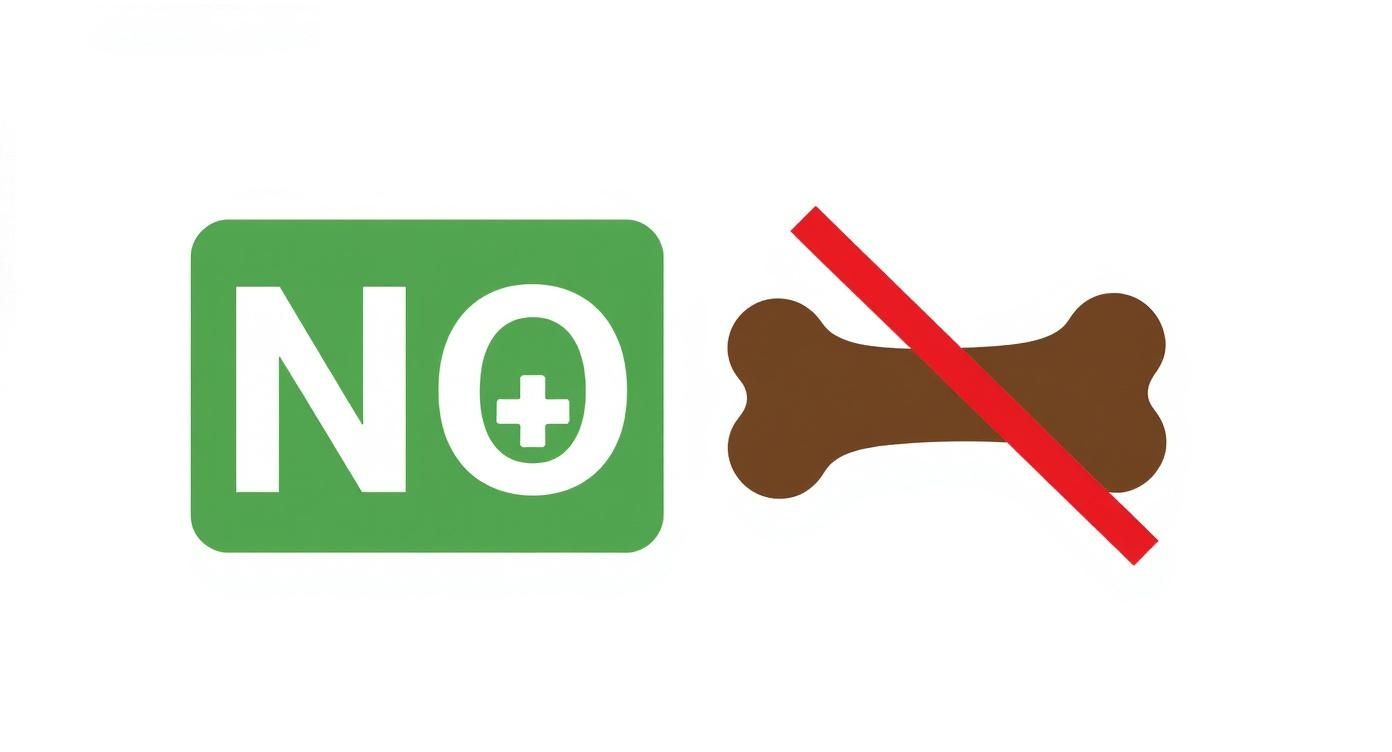
As you can see, when it comes to cooked turkey bones, the only safe answer from a vet's perspective is a hard "no."
Monitoring for Warning Signs
After you've spoken with the vet, they will almost certainly tell you to keep a very close eye on your dog for the next 24 to 72 hours. A swallowed bone can cause trouble anywhere along the digestive tract, from the throat to the intestines.
Here’s what you need to be watching for:
- Lethargy: Is your dog suddenly sluggish or unusually tired?
- Vomiting: This includes retching or gagging, even if nothing comes up.
- Straining to poop: Any obvious signs of constipation or difficulty.
- Bloody stool: Look for bright red blood or dark, tarry-looking stools.
- Loss of appetite: Refusing to eat is a major red flag.
- Abdominal pain: A hunched-over posture, whining when you touch their belly, or general restlessness can all signal pain.
If you spot any of these symptoms, it’s a true emergency. Call your vet immediately. This isn't a "wait and see" situation, as these signs could point to a life-threatening blockage or internal puncture that needs urgent medical care.
Safe and Healthy Alternatives Your Dog Will Love
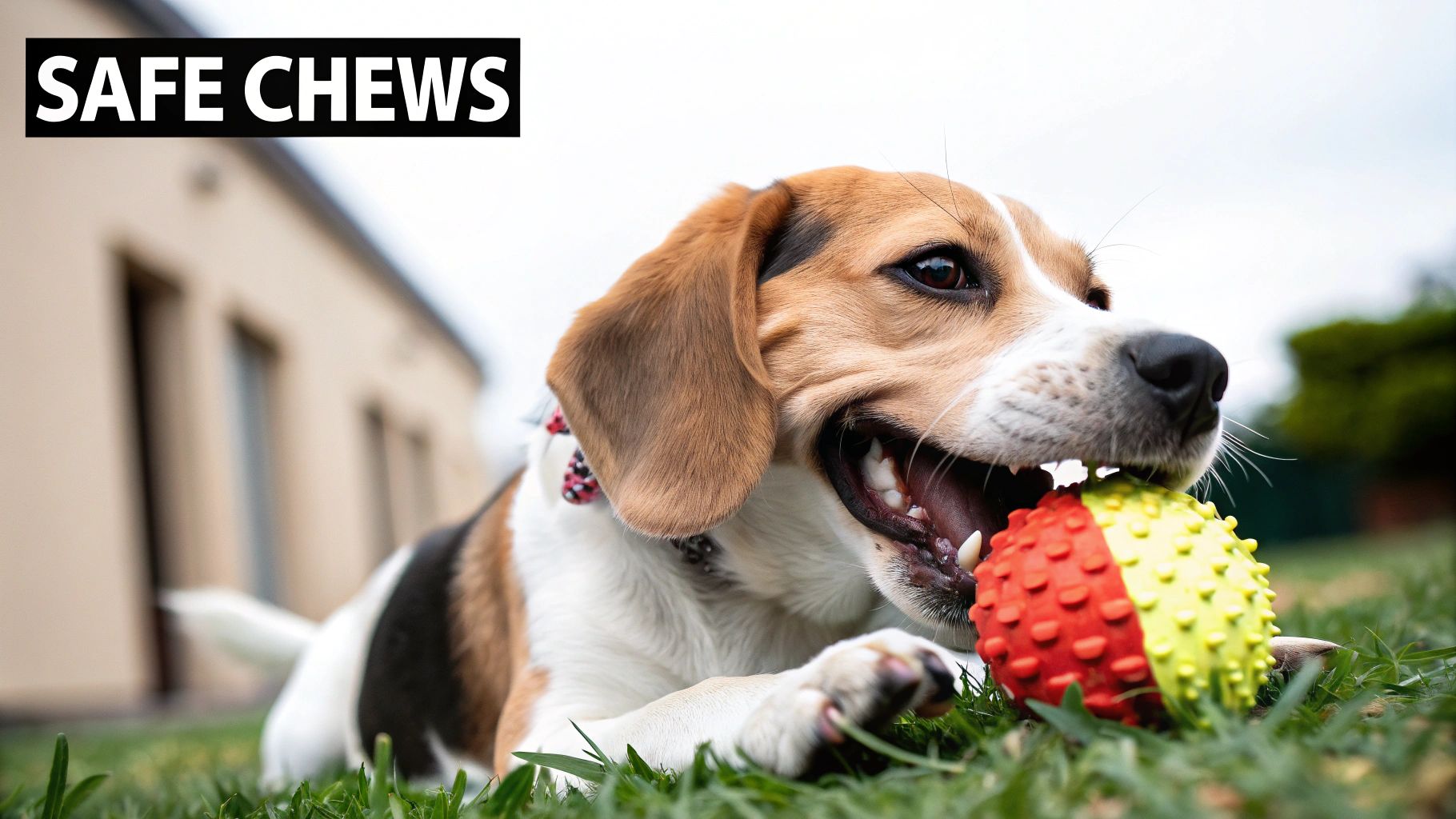
Okay, so turkey leg bones are officially off the menu. But that doesn't mean the fun has to stop! Now we get to explore the world of safe, satisfying chews that will keep your dog's tail wagging without sending you into a panic.
The great news is that there are tons of fantastic, vet-approved options out there. These alternatives satisfy your dog's natural urge to chew and actually contribute to their health, turning a risky habit into a rewarding activity.
Durable and Interactive Chew Toys
For dogs who love a good, long chewing session, nothing beats a toy designed specifically for safety and durability. Unlike real bones that can shatter into dangerous shards, these are engineered to stand up to some serious jaw power.
Here are a couple of go-to options:
- Nylon Chew Toys: These things are practically indestructible and built for the long haul. They come in all sorts of shapes, sizes, and even flavors, keeping your dog engaged while giving their jaw a safe workout.
- Interactive Rubber Toys: You've probably seen brands like Kong, and for good reason. Their tough rubber toys often have a hollow center perfect for stuffing with dog-friendly treats—think peanut butter, a little plain yogurt, or some kibble. It turns chew time into a brain game.
A mentally stimulated dog is a happy dog. Interactive toys don't just occupy their time; they challenge their brain, helping to reduce boredom and prevent destructive behaviors that often stem from a lack of engagement.
Chews That Boost Dental Health
Beyond tough toys, there are edible chews specifically designed to clean your dog’s teeth. While a cooked bone can easily crack a molar, these alternatives go to work fighting plaque and tartar with every chew.
Dental chews are made with a unique texture that scrapes away buildup as your dog gnaws on them. Many are also designed with special nubs and ridges to get into those hard-to-reach spots. It’s a win-win: they get a tasty treat, and you get a dog with fresher breath and healthier gums.
If you're looking for more great ideas, check out this guide to some of the best natural dog treats and chews on the market. Making the switch to a safer chew is such a simple way to make a huge difference in your dog's well-being.
Sorting Through the Turkey Talk: Your Questions Answered
When it comes to sharing holiday meals, it's natural to have questions. Let's clear up some of the most common ones about feeding turkey to your four-legged friend.
What Parts of the Turkey Can My Dog Actually Eat?
Yes, a little bit of turkey can be a wonderful treat! The key is to stick to small pieces of plain, cooked turkey meat. Make sure it's both boneless and skinless.
The skin is loaded with fat, which can upset their stomach or even lead to pancreatitis, and many common seasonings like onion and garlic are outright toxic to dogs. Keep it simple: unseasoned meat, served as a small snack, is the way to go.
What About Raw Turkey Bones? Aren't They Safer?
You'll hear some raw-feeding enthusiasts argue that raw bones are fine, but they still come with serious baggage. A raw bone can still fracture a tooth or become a dangerous choking hazard.
Beyond the physical risk, raw bones are a breeding ground for nasty bacteria like Salmonella. This not only endangers your dog but can also spread to the human members of your family. It's a risk that's just not worth taking.
So Turkey Necks and Wings are Out Too?
Absolutely. Cooked turkey necks and wings are just as hazardous as the leg bones. They contain numerous small, brittle bones that can splinter during chewing, creating a high risk for internal injury or blockage.
Even if they're raw, the potential for choking and bacterial contamination remains a major concern.
When in doubt, always remember this: The safest bet is to keep all bones from your meal far away from your dog. A few moments of treat time for them isn't worth a potential trip to the emergency vet.
Understanding what's safe extends beyond just the main course. For example, if you're curious about other table scraps, our guide on if dogs can eat chickpeas provides more great tips for healthy, pet-friendly snacks.
At Joyfull, our mission is to give pets the safe, high-quality nutrition they deserve. Check out our lineup of vet-approved recipes made with clean ingredients that will have your dog's tail wagging. Learn more at https://joyfullpet.com.
